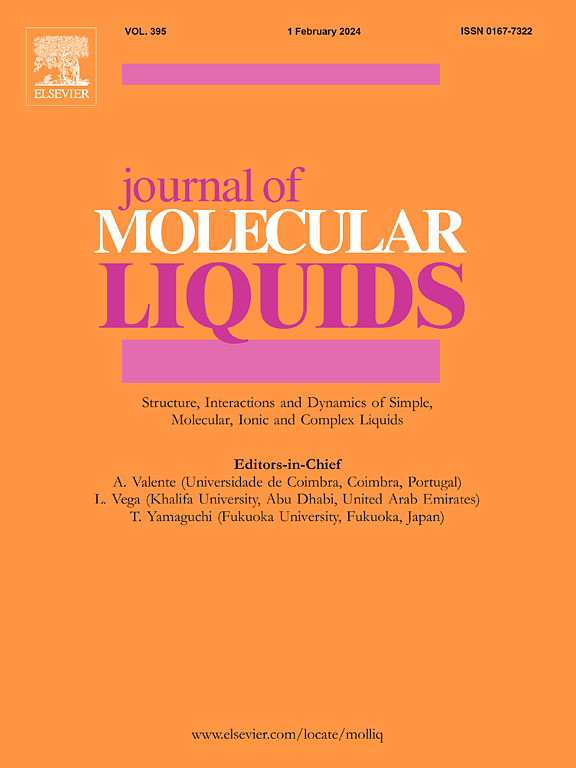结合离散傅立叶变换和分子对接计算,研究了不同介质中福山苷类和黄酮类化合物的光谱和结构
IF 5.3
2区 化学
Q2 CHEMISTRY, PHYSICAL
引用次数: 0
摘要
采用B3LYP/ 6-311 ++G(d,p)水平理论研究了藤黄属植物中morelloflavone (MFL)及其糖苷fukugiside (FKS)的结构特征和分子内相互作用。1H NMR, 13C NMR, FT-IR, FT-Raman和UV-Vis光谱分析也进行了。用TD-DFT研究了气相和溶剂(氯仿、DMSO、丙酮)中的电子吸收,揭示了溶剂对电子跃迁的显著影响。氯甲烷的紫外可见光谱证实了理论预测,通过NBO分析确定,关键跃迁分别为LP (2) O7→π* (C27-C30)和LP (2) O9→π* (C33-C35),稳定在30.89 kJ/mol和29.44 kJ/mol。通过ELF、LOL和RDG等拓扑工具表征了非共价相互作用和电子定位,阐明了弱相互作用区域和电子密度分布。分子静电势(MEP)图确定了分子的反应位点,而TDOS和过渡密度矩阵(TDM)分析证实了分子内的有效电荷转移。通过计算机研究获得了生物学上的见解。MFL对结核病表现出良好的抑制作用,而FKS对COVID-19表现出潜在的抗病毒活性。通过100 ns分子动力学模拟验证了分子对接结果,证实了配体-受体复合物的稳定性。此外,ADMET分析证实了两种分子的药物相似性和药代动力学活力。这项综合研究强调了MFL和FKS的结构、电子和药理学特性。本文章由计算机程序翻译,如有差异,请以英文原文为准。
Spectroscopic and structural studies of fukugiside and morelloflavone biflavonoids in different Media combined with DFT and molecular docking calculations
The structural features and intramolecular interactions of morelloflavone (MFL) and its glycoside fukugiside (FKS) from Garcinia species were investigated using B3LYP/6–311++G(d,p) level of theory. 1H NMR, 13C NMR, FT-IR, FT-Raman, and UV–Vis spectroscopic analyses were also performed. Electronic absorptions were explored with TD-DFT in the gas phase and solvents (chloroform, DMSO, acetone), revealing significant solvent effects on electronic transitions. UV–Vis spectra in chloroform corroborated theoretical predictions, with key transitions attributed to LP (2) O7 → π* (C27-C30) and LP (2) O9 → π* (C33-C35), stabilized at 30.89 kJ/mol and 29.44 kJ/mol, respectively, as identified through NBO analysis. Non-covalent interactions and electronic localization were characterized through topological tools such as ELF, LOL, and RDG, elucidating weak interaction regions and electron density distribution. The molecular electrostatic potential (MEP) map was used to identify the reactive sites of the molecules, while TDOS and transition density matrix (TDM) analyses confirmed efficient charge transfer within the molecules. Biological insights were obtained through in silico studies. MFL exhibited promising tuberculosis inhibition, while FKS showed potential antiviral activity against COVID-19. Molecular docking results were validated by 100 ns molecular dynamics simulations, confirming the stability of ligand-receptor complexes. Additionally, ADMET profiling affirmed the drug-likeness and pharmacokinetic viability of both molecules. This integrated study highlights the structural, electronic, and pharmacological attributes of MFL and FKS.
求助全文
通过发布文献求助,成功后即可免费获取论文全文。
去求助
来源期刊

Journal of Molecular Liquids
化学-物理:原子、分子和化学物理
CiteScore
10.30
自引率
16.70%
发文量
2597
审稿时长
78 days
期刊介绍:
The journal includes papers in the following areas:
– Simple organic liquids and mixtures
– Ionic liquids
– Surfactant solutions (including micelles and vesicles) and liquid interfaces
– Colloidal solutions and nanoparticles
– Thermotropic and lyotropic liquid crystals
– Ferrofluids
– Water, aqueous solutions and other hydrogen-bonded liquids
– Lubricants, polymer solutions and melts
– Molten metals and salts
– Phase transitions and critical phenomena in liquids and confined fluids
– Self assembly in complex liquids.– Biomolecules in solution
The emphasis is on the molecular (or microscopic) understanding of particular liquids or liquid systems, especially concerning structure, dynamics and intermolecular forces. The experimental techniques used may include:
– Conventional spectroscopy (mid-IR and far-IR, Raman, NMR, etc.)
– Non-linear optics and time resolved spectroscopy (psec, fsec, asec, ISRS, etc.)
– Light scattering (Rayleigh, Brillouin, PCS, etc.)
– Dielectric relaxation
– X-ray and neutron scattering and diffraction.
Experimental studies, computer simulations (MD or MC) and analytical theory will be considered for publication; papers just reporting experimental results that do not contribute to the understanding of the fundamentals of molecular and ionic liquids will not be accepted. Only papers of a non-routine nature and advancing the field will be considered for publication.
 求助内容:
求助内容: 应助结果提醒方式:
应助结果提醒方式:


